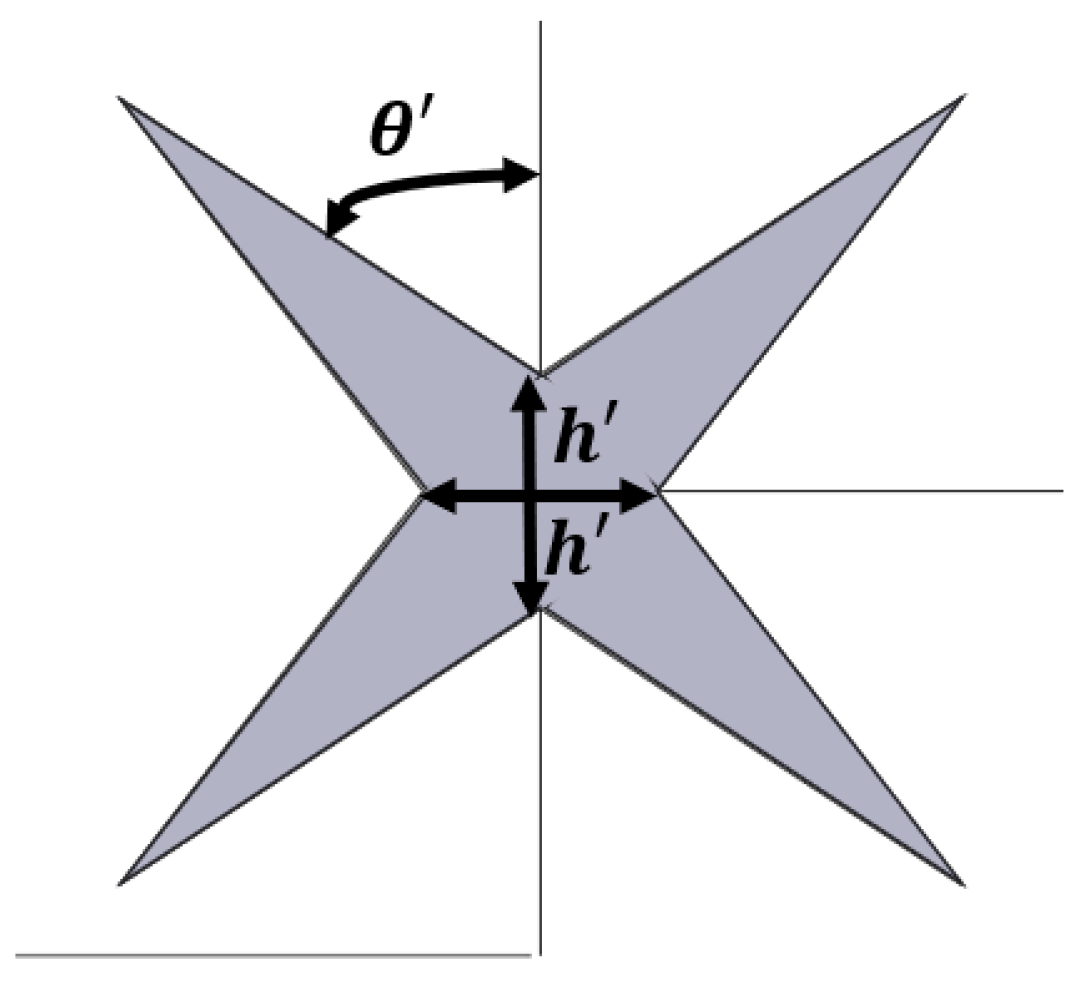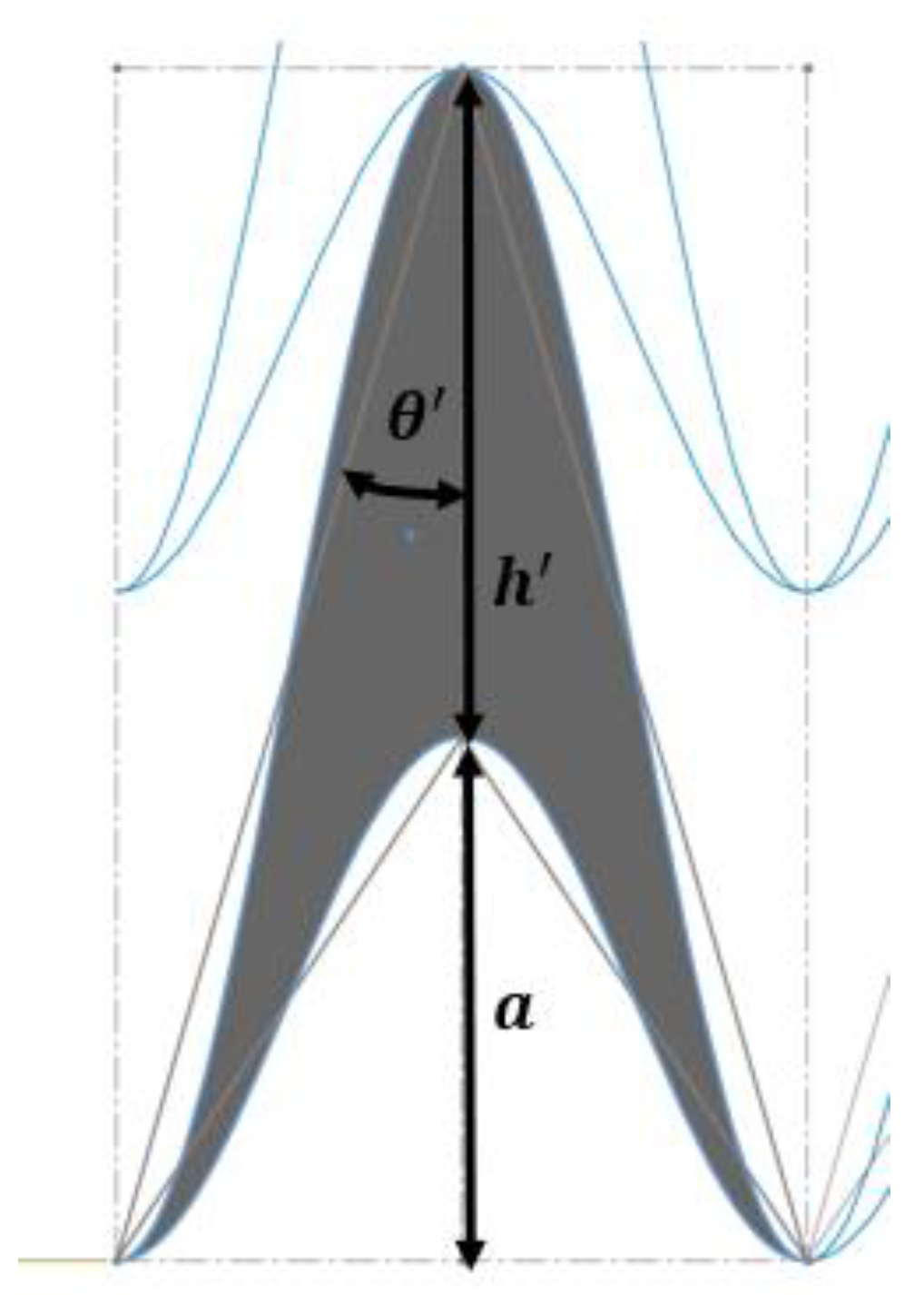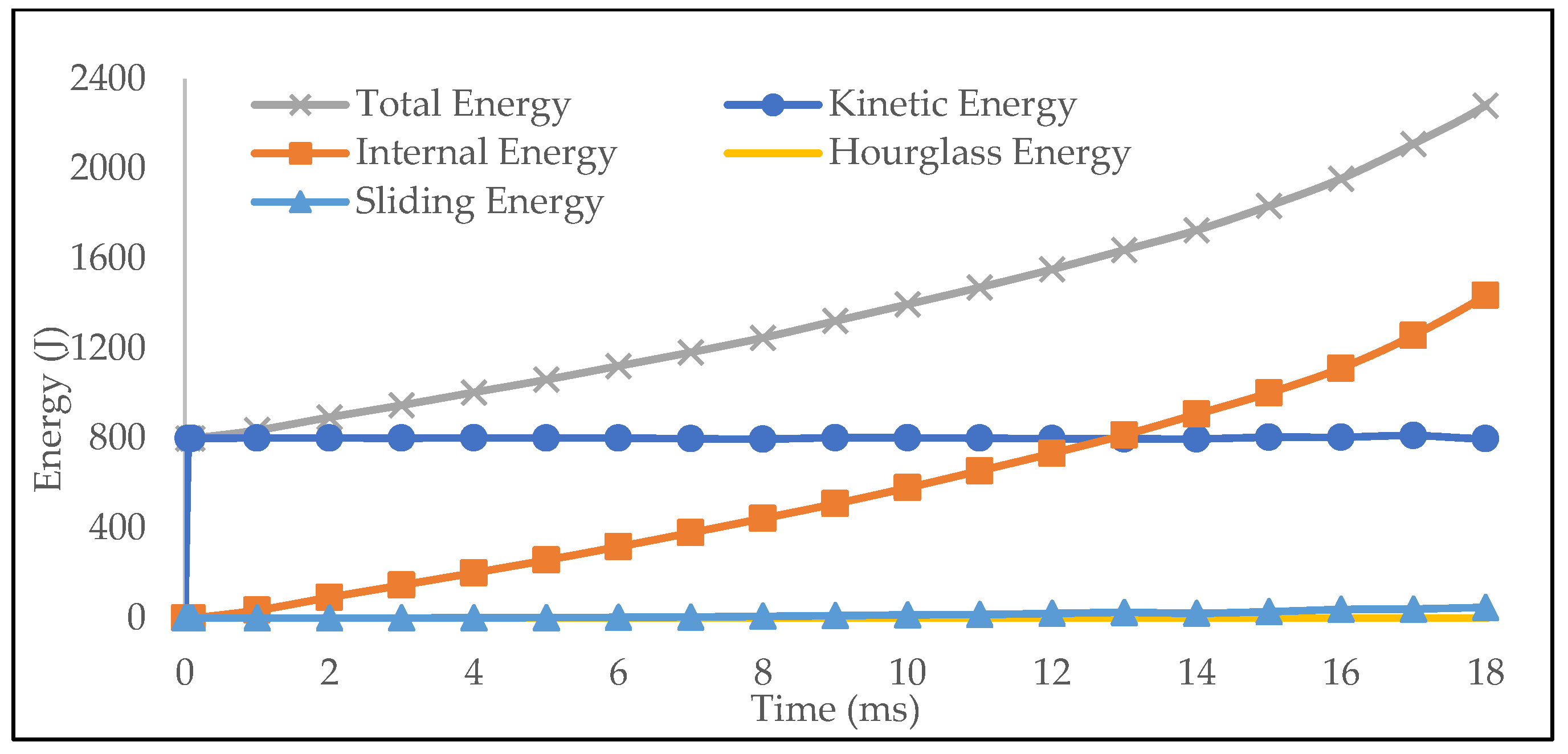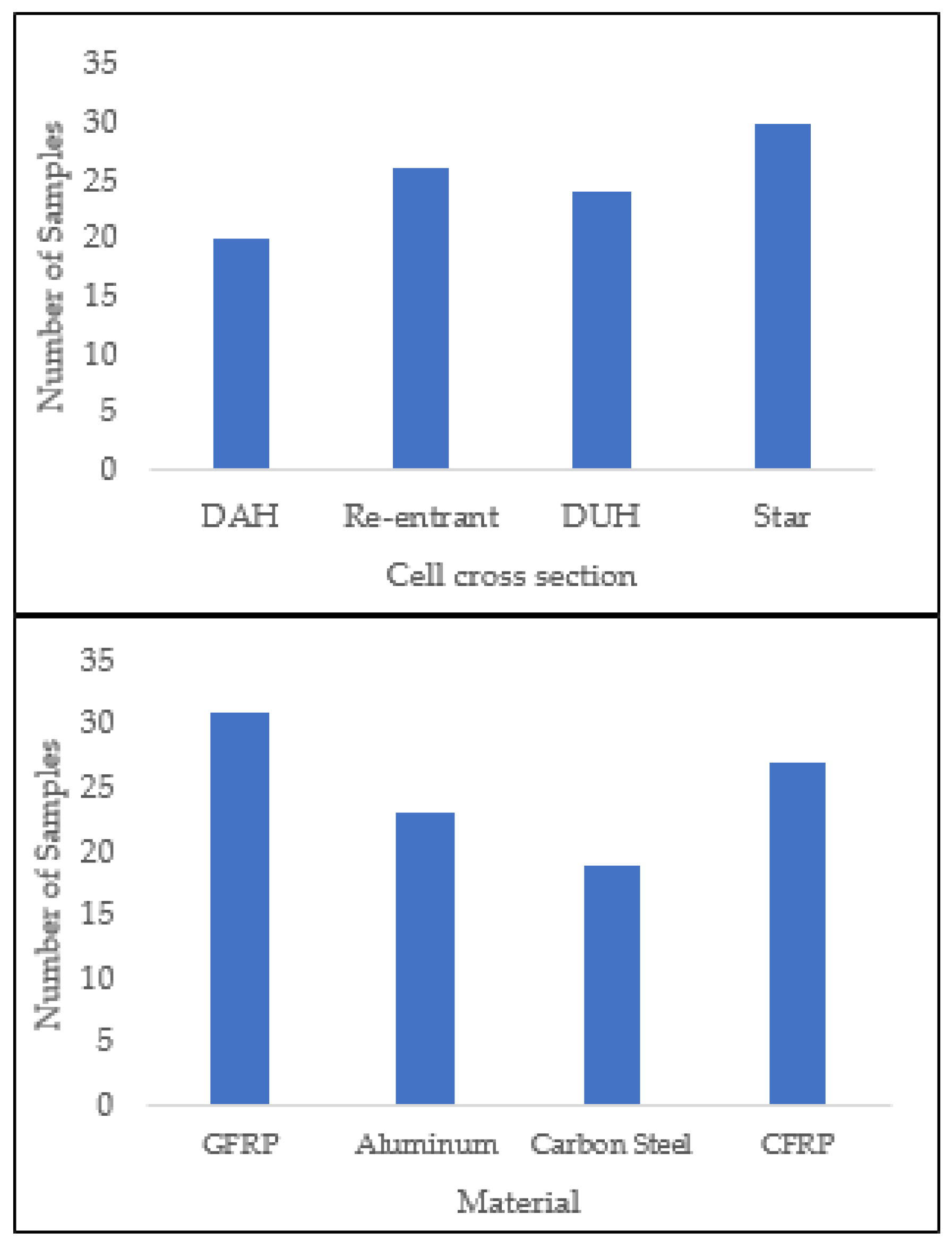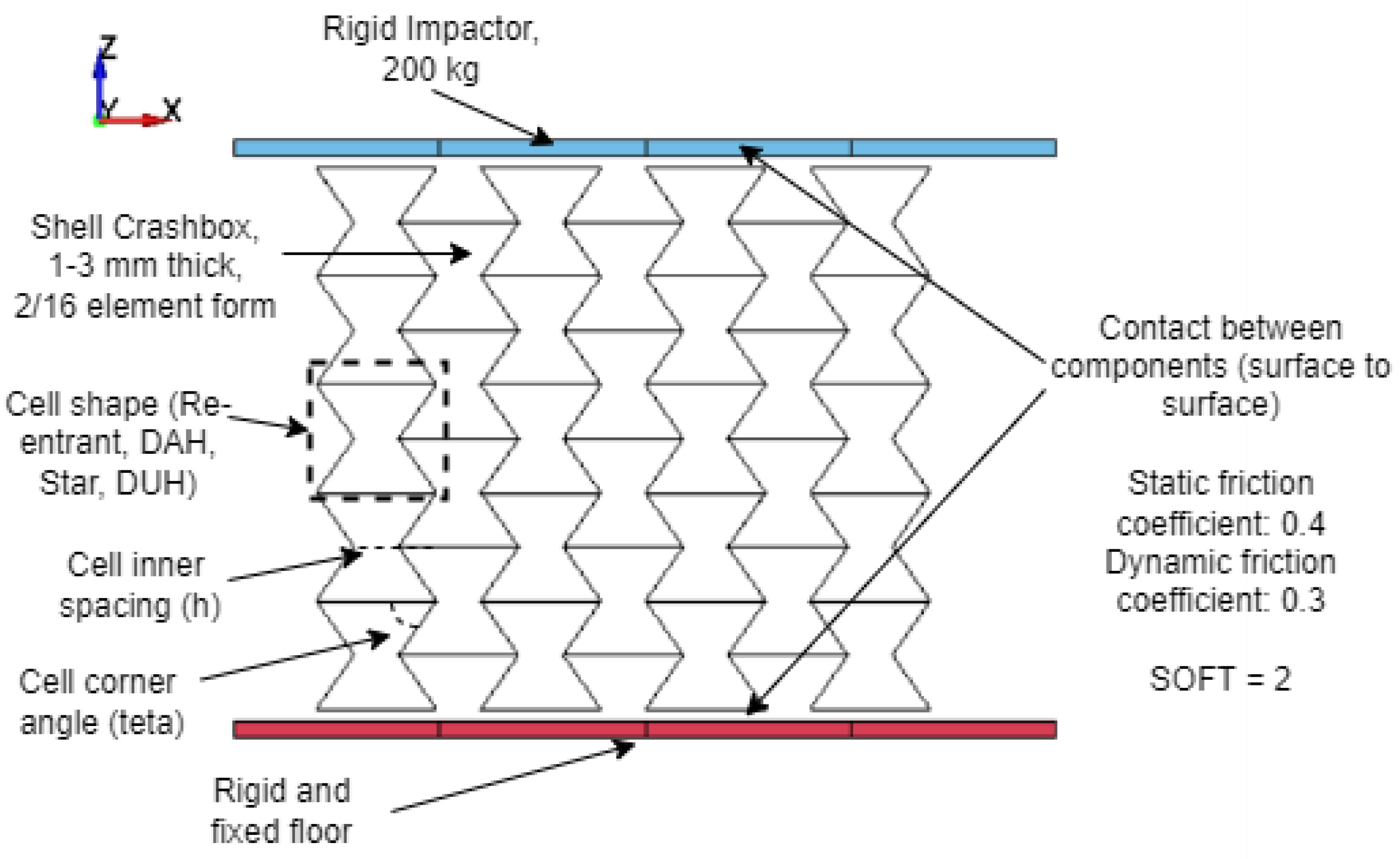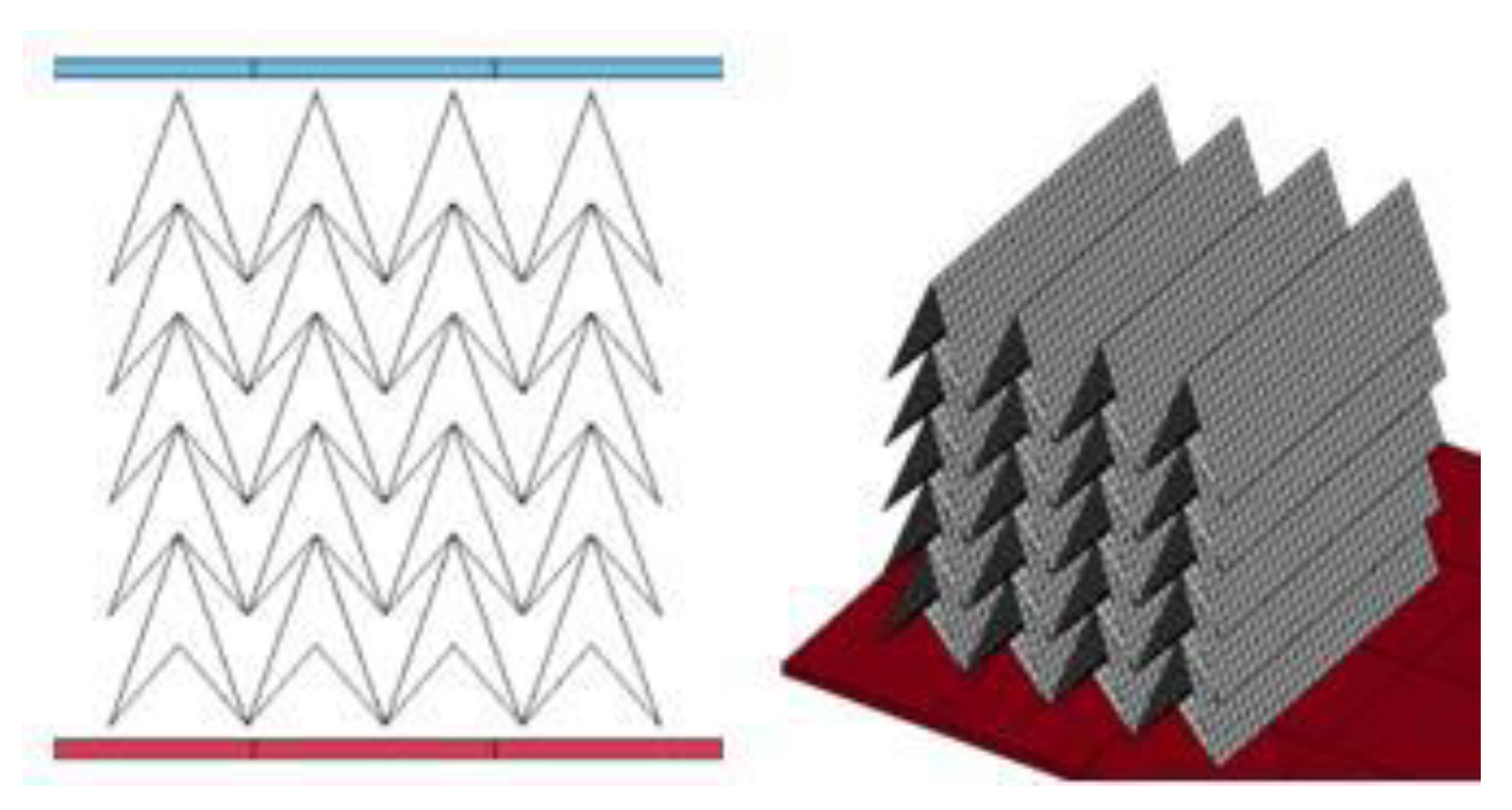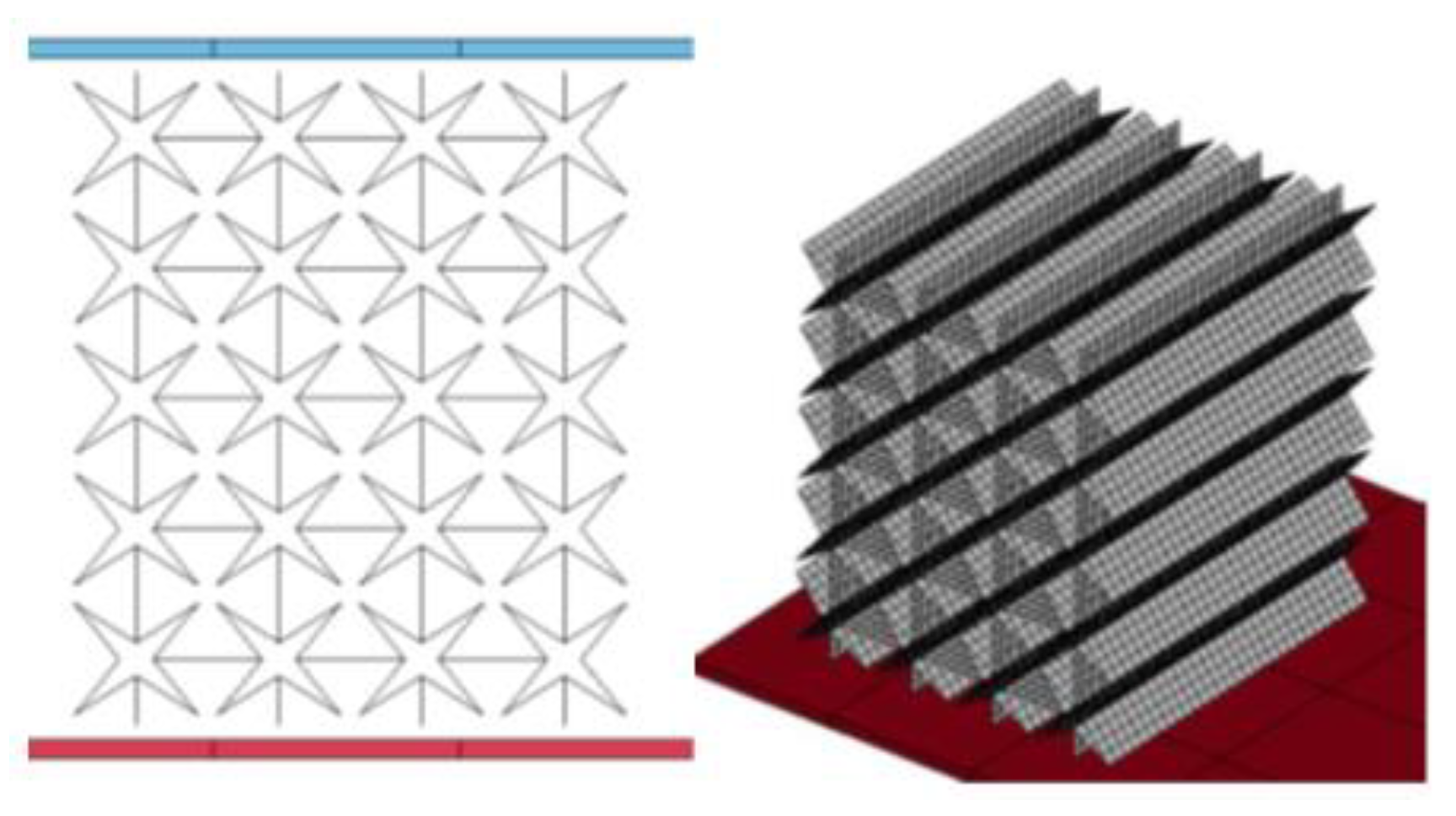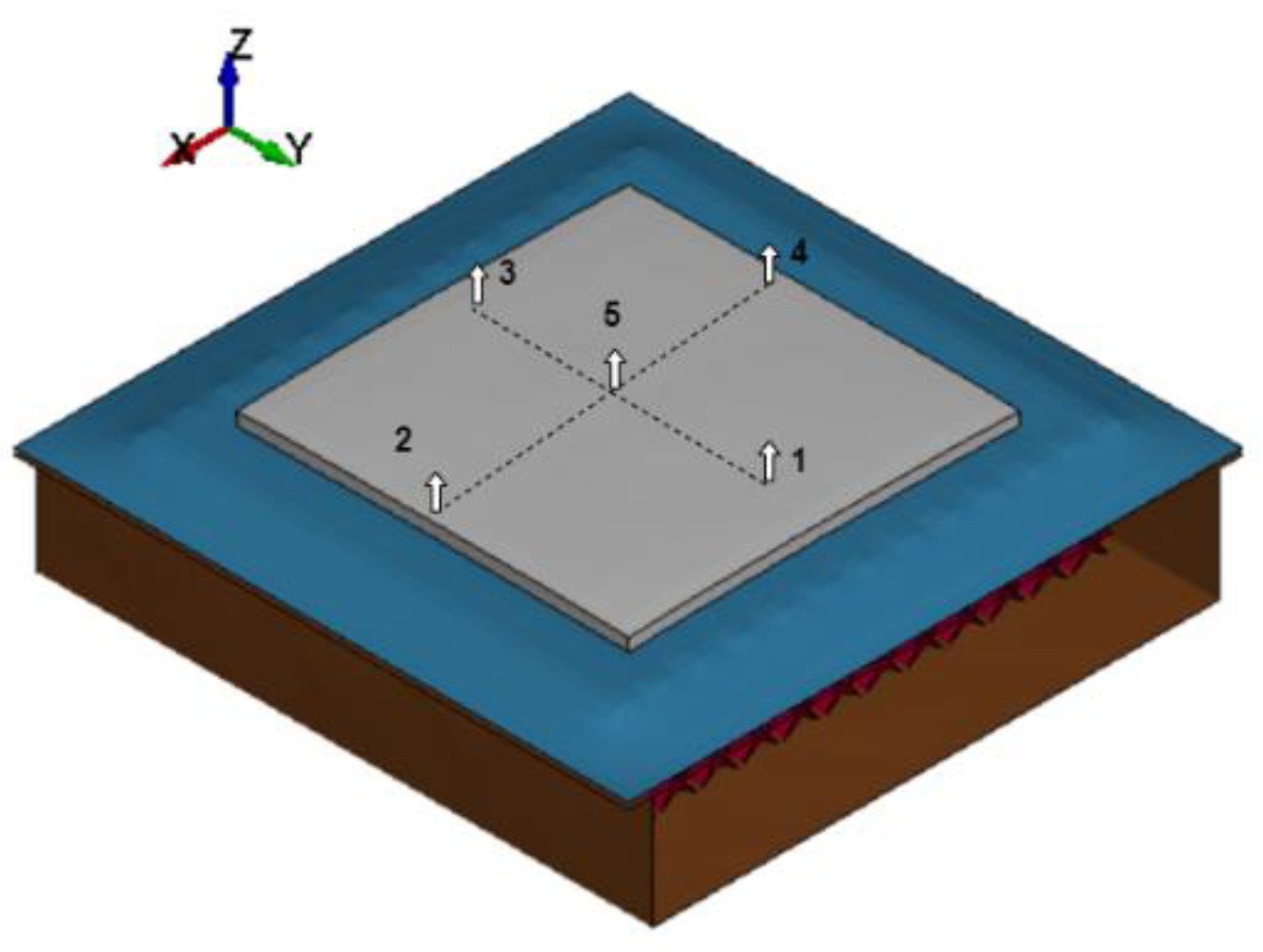Figure 1.
General auxetic honeycomb geometry definition. Thb and Thd indicate the cell’s thickness (which assumed to be equal), L and D indicates the cell’s side length, and indicates the cell’s corner angle.
Figure 1.
General auxetic honeycomb geometry definition. Thb and Thd indicate the cell’s thickness (which assumed to be equal), L and D indicates the cell’s side length, and indicates the cell’s corner angle.
Figure 2.
The baseline model from Wang’s study was reconstructed into a 3D model (upper left), then meshed to discretize the model for finite element analysis (upper right), and put together with a solid impactor and floor model on the top and bottom of the model to simulate the impact (bottom).
Figure 2.
The baseline model from Wang’s study was reconstructed into a 3D model (upper left), then meshed to discretize the model for finite element analysis (upper right), and put together with a solid impactor and floor model on the top and bottom of the model to simulate the impact (bottom).
Figure 3.
True stress strain curve of carbon steel.
Figure 3.
True stress strain curve of carbon steel.
Figure 4.
Force vs. displacement curve with SST variation to determine the SST value that provided the most accurate result compared with the baseline experiment. It can be seen that the higher the SST, the higher the force value.
Figure 4.
Force vs. displacement curve with SST variation to determine the SST value that provided the most accurate result compared with the baseline experiment. It can be seen that the higher the SST, the higher the force value.
Figure 5.
Crushing progression simulation compared with referenced experiment [
11].
Figure 5.
Crushing progression simulation compared with referenced experiment [
11].
Figure 6.
Crushing force vs. displacement from numerical simulation by writer compared with the baseline experiment.
Figure 6.
Crushing force vs. displacement from numerical simulation by writer compared with the baseline experiment.
Figure 7.
Impact energy plot from the numerical simulation. Total energy is the sum of all energy components. Since the simulation was quasi-static, the kinetic energy was constant. Note that the internal energy was continuously increasing, meaning that the structure absorbed the impact energy. Sliding energy indicates dissipated energy from contact, while hourglass energy is a non-physical energy that generated from numerical element distortion.
Figure 7.
Impact energy plot from the numerical simulation. Total energy is the sum of all energy components. Since the simulation was quasi-static, the kinetic energy was constant. Note that the internal energy was continuously increasing, meaning that the structure absorbed the impact energy. Sliding energy indicates dissipated energy from contact, while hourglass energy is a non-physical energy that generated from numerical element distortion.
Figure 8.
Baseline model height in millimeters (mm).
Figure 8.
Baseline model height in millimeters (mm).
Figure 9.
Total cell configuration height for each auxetic type in millimeter (mm), from upper left to lower left (clockwise): Re-entrant, DAH, DUH, Star.
Figure 9.
Total cell configuration height for each auxetic type in millimeter (mm), from upper left to lower left (clockwise): Re-entrant, DAH, DUH, Star.
Figure 14.
True stress-strain curve of carbon steel and aluminum Al6061-T6.
Figure 14.
True stress-strain curve of carbon steel and aluminum Al6061-T6.
Figure 15.
Generated sample space of continuous variables, which are cell thickness (t), corner angle (), inner spacing (h), and composite layer orientation.
Figure 15.
Generated sample space of continuous variables, which are cell thickness (t), corner angle (), inner spacing (h), and composite layer orientation.
Figure 16.
Generated sample space of categorical variables, which are cell cross section and material type.
Figure 16.
Generated sample space of categorical variables, which are cell cross section and material type.
Figure 17.
Generated sample space of continuous variables in a three-dimensional space, which are cell inner spacing (h), material thickness, and cell corner angle. One node indicates one variable combination.
Figure 17.
Generated sample space of continuous variables in a three-dimensional space, which are cell inner spacing (h), material thickness, and cell corner angle. One node indicates one variable combination.
Figure 18.
Numerical simulation configuration to obtain the specific energy absorption in each sample, consisting of the cell structure, impactor, and floor.
Figure 18.
Numerical simulation configuration to obtain the specific energy absorption in each sample, consisting of the cell structure, impactor, and floor.
Figure 19.
Numerical simulation configuration of Re-entrant cells.
Figure 19.
Numerical simulation configuration of Re-entrant cells.
Figure 20.
Numerical simulation configuration of DAH cells.
Figure 20.
Numerical simulation configuration of DAH cells.
Figure 21.
Numerical simulation configuration of Star-shaped cells.
Figure 21.
Numerical simulation configuration of Star-shaped cells.
Figure 22.
Numerical simulation configuration of DUH cells.
Figure 22.
Numerical simulation configuration of DUH cells.
Figure 23.
ANN model architecture (input, hidden, and output layers configuration), which consisted of neurons (nodes) and its connecting line.
Figure 23.
ANN model architecture (input, hidden, and output layers configuration), which consisted of neurons (nodes) and its connecting line.
Figure 24.
Numerical simulation configuration of the optimized (left) and baseline model (right).
Figure 24.
Numerical simulation configuration of the optimized (left) and baseline model (right).
Figure 25.
Comparison of the force vs. displacement curve between the optimized and baseline model. It can be seen that the optimized model had a higher force amount compared with the baseline model.
Figure 25.
Comparison of the force vs. displacement curve between the optimized and baseline model. It can be seen that the optimized model had a higher force amount compared with the baseline model.
Figure 26.
Energy plot for the baseline (upper) and optimized (lower) model during the impact.
Figure 26.
Energy plot for the baseline (upper) and optimized (lower) model during the impact.
Figure 27.
Battery system configuration with the cell.
Figure 27.
Battery system configuration with the cell.
Figure 28.
Numerical impact simulation result.
Figure 28.
Numerical impact simulation result.
Figure 29.
Impact energy plot of the complete battery system (battery and protection structure).
Figure 29.
Impact energy plot of the complete battery system (battery and protection structure).
Figure 30.
Impact energy curve of the protection structure only.
Figure 30.
Impact energy curve of the protection structure only.
Figure 31.
Measurement positions to check the battery deformation.
Figure 31.
Measurement positions to check the battery deformation.
Figure 32.
Change in the local battery thickness throughout the simulation. Note that points 1 and 3 experienced almost similar deformation; therefore, the curve overlaps each other.
Figure 32.
Change in the local battery thickness throughout the simulation. Note that points 1 and 3 experienced almost similar deformation; therefore, the curve overlaps each other.
Table 1.
Unit cell parameters for the baseline NPR model.
Table 1.
Unit cell parameters for the baseline NPR model.
| Unit Cell Parameters | Value |
|---|
| D | 13.70 mm |
| L | 8.00 mm |
| Thb, Thd | 1.00 mm |
| 55.40 |
Table 2.
Material properties of the baseline model.
Table 2.
Material properties of the baseline model.
| Material Properties | Value |
|---|
| Type | Carbon Steel |
| Density (ρ) | 7850.0 kg/m3 |
| Young Mod (E) | 210.0 GPa |
| Yield Strength () | 350.0 MPa |
| Poisson’s Ratio (ν) | 0.3 |
Table 3.
Variables for the design optimization.
Table 3.
Variables for the design optimization.
| Predictor Variable | Output Variable |
|---|
| | Continuous Variable | Categorical Variable |
|---|
| Geometry Definition | h (inner cell spacing) | 4.5–6 mm
( 0.15 mm) | Cross-section shape | Re-entrant, DAH, Star, DUH | Specific Energy Absorption (SEA) |
| (angle of cell’s corner | 45–60°
( 1°) |
| Material Definition | Material thickness | 1–3 mm
( 0.2 mm) | Composite number of layers | 2, 4, 6, 8, 10, 12 |
| Composite ply orientation | 0–180°
( 15°) |
Table 4.
Material properties for non-composite materials (carbon steel and aluminum).
Table 4.
Material properties for non-composite materials (carbon steel and aluminum).
| Non-Composite Material Properties | Value | Unit |
|---|
| | Type | Carbon Steel | Aluminium (Al6061-T6) | - |
|---|
| Basic Mechanical Property | Density (ρ) | 7850.0 | 2700 | kg/m3 |
| Young Mod (E) | 210.0 | 68.9 | GPa |
| Yield Strength () | 350.0 | 276 | MPa |
| Poisson’s Ratio (ν) | 0.3 | 0.33 | - |
| Strain-rate sensitivity | C | - | 25,000 | |
| P | - | 0.95 | |
Table 5.
Composite material properties.
Table 5.
Composite material properties.
| Composite Material Properties | Value | Unit |
|---|
| Type | GFRP | CFRP | - |
|---|
| Density (ρ) | 1600.0 | 2700 | kg/m3 |
| Longitudinal Young Mod. (E1) | 75.6 | 68.9 | GPa |
| Lateral Young Mod. (E2) | 17.7 | 68.9 | GPa |
| In-plane shear mod. (G12) | 2.8 | 5.24 | GPa |
| Out-of-plane shear mod. (G23) | - | 2.24 | |
| In-plane shear strength (S12) | 0.07 | 0.071 | GPa |
| Longtd. Tensile strength (XT) | 1.33 | 2.28 | GPa |
| Transv. Tensile str. (YT) | 0.069 | 0.057 | GPa |
| Longtd. Compressive str. (XC) | 0.547 | 1.44 | GPa |
| Tranvs. Compressive str. (YC) | 0.262 | 0.228 | GPa |
| In-plane Poisson Ratio (PR12) | 0.3 | 0.021 | - |
| Out-of-plane Poisson Rat. (PR13) | - | 0.021 | - |
| max | - | 1.38% | - |
| max | - | 1.175% | - |
Table 6.
Categorical variables transformation to dummy variables. This pre-processing was performed using the OneHotEncoder algorithm, which encodes categorical features as a one-hot numeric array. In addition, dummy variable “1” was removed from each categorical variable to prevent a “dummy trap” (multi-collinearity between two variables) [
29].
Table 6.
Categorical variables transformation to dummy variables. This pre-processing was performed using the OneHotEncoder algorithm, which encodes categorical features as a one-hot numeric array. In addition, dummy variable “1” was removed from each categorical variable to prevent a “dummy trap” (multi-collinearity between two variables) [
29].
| Categorical Variable | Variable Index | Dummy Variable |
|---|
| 1 | 2 | 3 | 4 |
|---|
| Cross-section shape | Re-entrant | 1 | 1 | 0 | 0 | 0 |
| DAH | 2 | 0 | 1 | 0 | 0 |
| Star | 3 | 0 | 0 | 1 | 0 |
| DUH | 4 | 0 | 0 | 0 | 1 |
| Material type | GFRP | 1 | 1 | 0 | 0 | 0 |
| CFRP | 2 | 0 | 1 | 0 | 0 |
| Carbon Steel | 3 | 0 | 0 | 1 | 0 |
| Aluminium | 4 | 0 | 0 | 0 | 1 |
Table 7.
Neuron units, weights, biases, and activation function in each ANN layer.
Table 7.
Neuron units, weights, biases, and activation function in each ANN layer.
| Layer | Number of Neuron Units | Number of Weight | Number of Bias | Activation Function |
|---|
| Dense_1 (Input to Hidden Layer 1) | 16 | 160 | 10 | Linear |
| Dense_2 (Hidden Layer 1 to 2) | 10 | 100 | 10 | Relu |
| Dense_3 (Hidden Layer 2 to 3) | 10 | 100 | 10 | Sigmoid |
| Dense_4 (Hidden Layer 3 to 4) | 10 | 100 | 10 | Relu |
| Dense_5 (Hidden Layer 4 to 5) | 10 | 100 | 10 | Sigmoid |
| Dense_6 (Hidden Layer 5 to 6) | 10 | 100 | 10 | Relu |
| Dense_7 (Output) | 1 | 10 | 1 | Sigmoid |
Table 8.
Input variables for the design optimization.
Table 8.
Input variables for the design optimization.
| Input Number | Variable | Data Type |
|---|
| 1 | Dummy 2 Cell Shape (DAH) | Boolean (0/1) |
| 2 | Dummy 3 Cell Shape (Star) | Boolean (0/1) |
| 3 | Dummy 4 Cell Shape (DUH) | Boolean (0/1) |
| 4 | Dummy 2 Material (CFRP) | Boolean (0/1) |
| 5 | Dummy 3 Material (Carbon Steel) | Boolean (0/1) |
| 6 | Dummy 4 Material (Aluminium) | Boolean (0/1) |
| 7 | Inner spacing (h) | Float (4.5–6) |
| 8 | Thickness | Float (1–3) |
| 9 | Corner angle | Float (45–60) |
| 10 | Number of layers | Integer (2, 4, 6, 8, 10, 12) |
| 11 | Layer 1 & 12 Orientation | Float (0–3) |
| 12 | Layer 2 & 11 Orientation | Float (0–3) |
| 13 | Layer 3 & 10 Orientation | Float (0–3) |
| 14 | Layer 4 & 9 Orientation | Float (0–3) |
| 15 | Layer 5 & 8 Orientation | Float (0–3) |
| 16 | Layer 6 & 7 Orientation | Float (0–3) |
Table 9.
Parameters for Sequential() function as predictor algorithm.
Table 9.
Parameters for Sequential() function as predictor algorithm.
| Parameter | Value |
|---|
| Learning Batch | 5 |
| Validation Data Split | 20% |
| Epoch (number of iterations) | 4000 |
| Epoch Step | 300 |
| Initialization | Normal Distribution |
| Activation Function | Linear, ReLU (Rectified Linear Unit), and Sigmoid |
| ANN Optimizer | Adam |
| Error Parameter | Mean Squared Error (MSE) |
Table 10.
ANN model metrics (MSE and MAE) at Epoch 4000.
Table 10.
ANN model metrics (MSE and MAE) at Epoch 4000.
| Parameter | Training Set | Validation Set |
|---|
| Mean Squared Error (MSE) | 2.64 × 10−7 | 0.0274 |
| Mean Absolute Error (MAE) | 2.49 × 10−4 | 0.1245 |
Table 11.
Obtained optimum design variables.
Table 11.
Obtained optimum design variables.
| Design Details | Value | Unit |
|---|
| Cross-section | Star | - |
| Material | Aluminium | - |
| Cell inner spacing () | 5.557 | mm |
| Material thickness () | 2.95 | mm |
| Cell corner angle () | 56.82 | degrees |
| Number of the composite layer | 0 | |
| Predicted SEA | 37,346.37 | J/kg |
Table 12.
Design input and output variables. The optimized model had 1220.6% higher SEA than the baseline model, and the SEA approximation error of ANN-NSGA method was equal to 6.7% compared with the FEM.
Table 12.
Design input and output variables. The optimized model had 1220.6% higher SEA than the baseline model, and the SEA approximation error of ANN-NSGA method was equal to 6.7% compared with the FEM.
| | Baseline Model | Optimized Model |
|---|
| Design Input Variables | Value | Unit | Value | Unit |
| Cross-section | Re-entrant | - | Star | - |
| Material | Carbon Steel | - | Aluminium | - |
| Cell inner spacing (h) | 4.6 | mm | 5.6 | mm |
| Material thickness (t) | 1.0 | mm | 2.9 | mm |
| Cell corner angle () | 55.4 | degrees | 56.8 | degrees |
| # of composite layer | 0 | - | 0 | - |
| Output Variables | Value | Unit | Value | Unit |
| Mass | 0.6 | kg | 0.7 | kg |
| Energy Absorbed | 1676.2 | J | 28,579.6 | J |
| Calculated SEA from FEM | 3031.0 | J/kg | 40,027.4 | J/kg |
| Predicted SEA from ANN-NSGA | - | - | 37,346.4 | J/kg |
| Error between ANN-NSGA and FEM | 6.7% |
| Comparison of Optimized SEA with Baseline SEA | 1220.6% |
Table 13.
Deformation value at each measured point.
Table 13.
Deformation value at each measured point.
| Deformation (in mm) | Point 1 | Point 2 | Point 3 | Point 4 | Point 5 |
|---|
| Maximum | −1.338 | −0.799 | −1.336 | −0.746 | −1.058 |
| Minimum | −9.54 × 10−7 | −5.09 × 10−3 | −1.00 × 10−6 | −6.38 × 10−3 | 0.000 |


